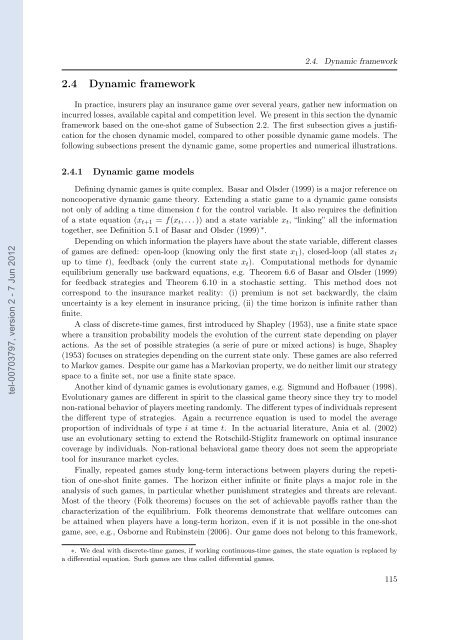Etude des marchés d'assurance non-vie à l'aide d'équilibres de ...
Etude des marchés d'assurance non-vie à l'aide d'équilibres de ...
Etude des marchés d'assurance non-vie à l'aide d'équilibres de ...
Create successful ePaper yourself
Turn your PDF publications into a flip-book with our unique Google optimized e-Paper software.
tel-00703797, version 2 - 7 Jun 2012<br />
2.4 Dynamic framework<br />
2.4. Dynamic framework<br />
In practice, insurers play an insurance game over several years, gather new information on<br />
incurred losses, available capital and competition level. We present in this section the dynamic<br />
framework based on the one-shot game of Subsection 2.2. The first subsection gives a justification<br />
for the chosen dynamic mo<strong>de</strong>l, compared to other possible dynamic game mo<strong>de</strong>ls. The<br />
following subsections present the dynamic game, some properties and numerical illustrations.<br />
2.4.1 Dynamic game mo<strong>de</strong>ls<br />
Defining dynamic games is quite complex. Basar and Ols<strong>de</strong>r (1999) is a major reference on<br />
<strong>non</strong>cooperative dynamic game theory. Extending a static game to a dynamic game consists<br />
not only of adding a time dimension t for the control variable. It also requires the <strong>de</strong>finition<br />
of a state equation (xt+1 = f(xt, . . . )) and a state variable xt, “linking” all the information<br />
together, see Definition 5.1 of Basar and Ols<strong>de</strong>r (1999) ∗ .<br />
Depending on which information the players have about the state variable, different classes<br />
of games are <strong>de</strong>fined: open-loop (knowing only the first state x1), closed-loop (all states xt<br />
up to time t), feedback (only the current state xt). Computational methods for dynamic<br />
equilibrium generally use backward equations, e.g. Theorem 6.6 of Basar and Ols<strong>de</strong>r (1999)<br />
for feedback strategies and Theorem 6.10 in a stochastic setting. This method does not<br />
correspond to the insurance market reality: (i) premium is not set backwardly, the claim<br />
uncertainty is a key element in insurance pricing, (ii) the time horizon is infinite rather than<br />
finite.<br />
A class of discrete-time games, first introduced by Shapley (1953), use a finite state space<br />
where a transition probability mo<strong>de</strong>ls the evolution of the current state <strong>de</strong>pending on player<br />
actions. As the set of possible strategies (a serie of pure or mixed actions) is huge, Shapley<br />
(1953) focuses on strategies <strong>de</strong>pending on the current state only. These games are also referred<br />
to Markov games. Despite our game has a Markovian property, we do neither limit our strategy<br />
space to a finite set, nor use a finite state space.<br />
Another kind of dynamic games is evolutionary games, e.g. Sigmund and Hofbauer (1998).<br />
Evolutionary games are different in spirit to the classical game theory since they try to mo<strong>de</strong>l<br />
<strong>non</strong>-rational behavior of players meeting randomly. The different types of individuals represent<br />
the different type of strategies. Again a recurrence equation is used to mo<strong>de</strong>l the average<br />
proportion of individuals of type i at time t. In the actuarial literature, Ania et al. (2002)<br />
use an evolutionary setting to extend the Rotschild-Stiglitz framework on optimal insurance<br />
coverage by individuals. Non-rational behavioral game theory does not seem the appropriate<br />
tool for insurance market cycles.<br />
Finally, repeated games study long-term interactions between players during the repetition<br />
of one-shot finite games. The horizon either infinite or finite plays a major role in the<br />
analysis of such games, in particular whether punishment strategies and threats are relevant.<br />
Most of the theory (Folk theorems) focuses on the set of achievable payoffs rather than the<br />
characterization of the equilibrium. Folk theorems <strong>de</strong>monstrate that wellfare outcomes can<br />
be attained when players have a long-term horizon, even if it is not possible in the one-shot<br />
game, see, e.g., Osborne and Rubinstein (2006). Our game does not belong to this framework,<br />
∗. We <strong>de</strong>al with discrete-time games, if working continuous-time games, the state equation is replaced by<br />
a differential equation. Such games are thus called differential games.<br />
115
















